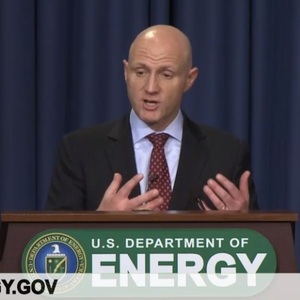Simmons sworn in as assistant secretary of DOE's EERE

SOURCE: U.S. Department of Energy
February 7, 2019
BY Erin Krueger
The U.S. Department of Energy’s Office of Energy Efficiency and Renewable Energy has a new leader. Daniel Simmons was recently sworn in assistant secretary for energy efficiency and renewable energy.
Simmons was confirmed for the post by the U.S. Senate on Jan. 2 and officially sworn in to the assistant secretary role on Jan. 16. On Feb. 6, the DOE was ceremonially sworn in by Secretary of Energy Rick Perry during a ceremony held to honor him and his new role before his family, friends and colleagues.
Advertisement
President Trump first nominated Simmons to the post of assistant secretary for energy efficiency and renewable energy on June 14, 2018. Information released by the White House indicates he previously served as the principal deputy assistant secretary for the DOE’s EERE. In that position, he oversaw technology development in the energy efficiency, renewable power, and sustainable transportation sectors. Prior to his government service, Simmons served as vice president for policy at the Institute for Energy Research. He also previously served as the director of the Natural Resources Task Force at the American Legislative Exchange Council, was a research fellow at the Mercatus Center, and worked as professional staff on the U.S. House of Representatives Committee on Resources.
In his new role, Simmons will oversee technology development in the energy efficiency, renewable power and sustainable transportations sectors.
“From the moment I was sworn in as Secretary, I’ve been clear that we’re committed to an all-of-the-above energy policy. I have the utmost confidence that Assistant Secretary Simmons is going to excel with the EERE team to make American energy abundant, affordable, efficient, and secure,” Perry said.
Advertisement
“Thanks to the power of innovation, we have become the world’s second highest generator of wind and solar power,” said Under Secretary of Energy Mark W. Menezes. “Renewables, along with energy storage and energy efficiency, are critical elements of our overall energy and economic strategy, and I am pleased to have Assistant Secretary Simmons on board to continue advancing our country’s renewable technologies.”
Related Stories
The U.S. Energy Information Administration maintained its forecast for 2025 and 2026 biodiesel, renewable diesel and sustainable aviation fuel (SAF) production in its latest Short-Term Energy Outlook, released July 8.
XCF Global Inc. on July 10 shared its strategic plan to invest close to $1 billion in developing a network of SAF production facilities, expanding its U.S. footprint, and advancing its international growth strategy.
U.S. fuel ethanol capacity fell slightly in April, while biodiesel and renewable diesel capacity held steady, according to data released by the U.S. EIA on June 30. Feedstock consumption was down when compared to the previous month.
XCF Global Inc. on July 8 provided a production update on its flagship New Rise Reno facility, underscoring that the plant has successfully produced SAF, renewable diesel, and renewable naphtha during its initial ramp-up.
The U.S. EPA on July 8 hosted virtual public hearing to gather input on the agency’s recently released proposed rule to set 2026 and 2027 RFS RVOs. Members of the biofuel industry were among those to offer testimony during the event.
Upcoming Events










